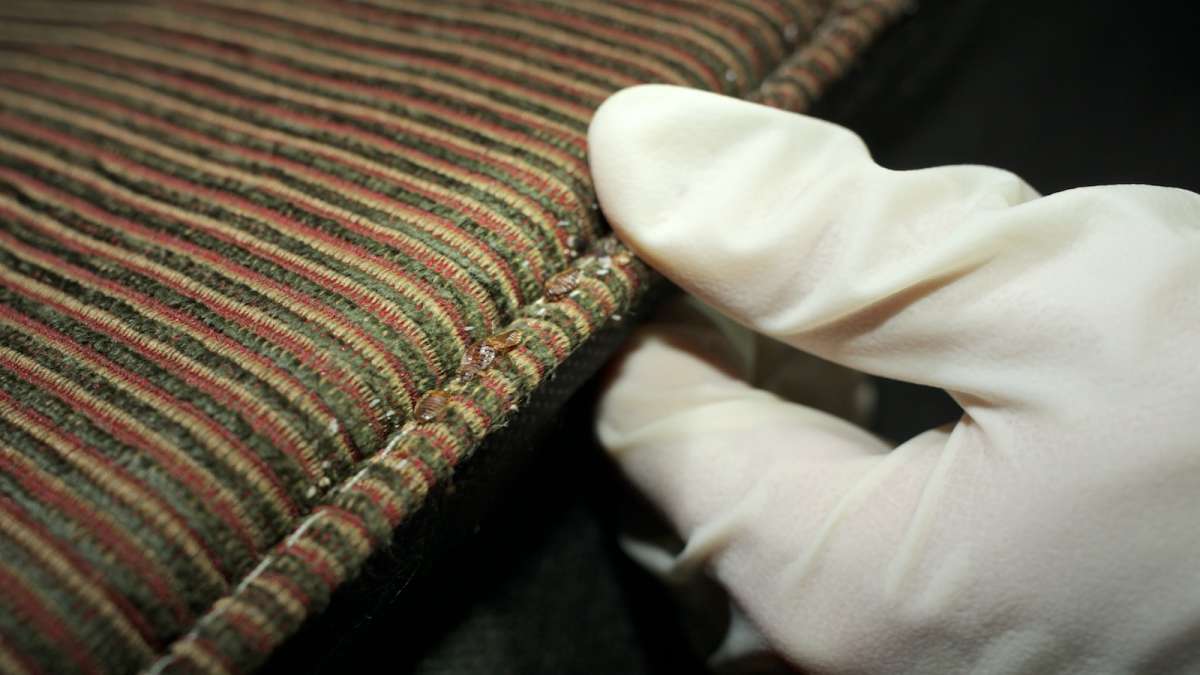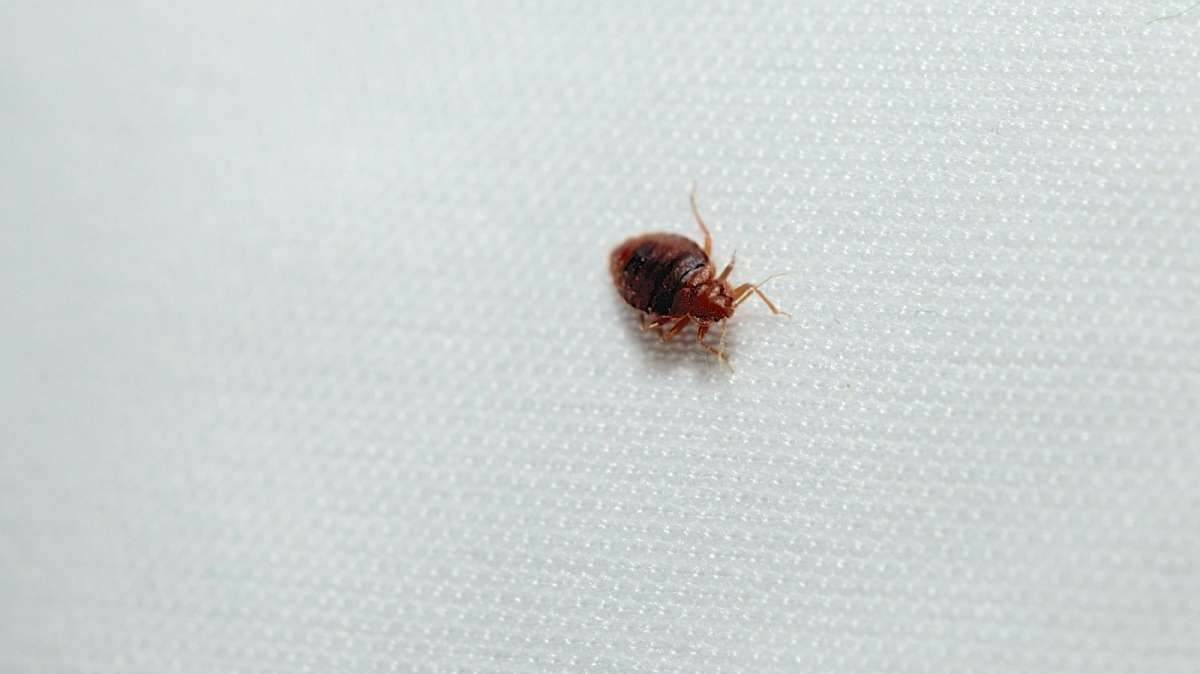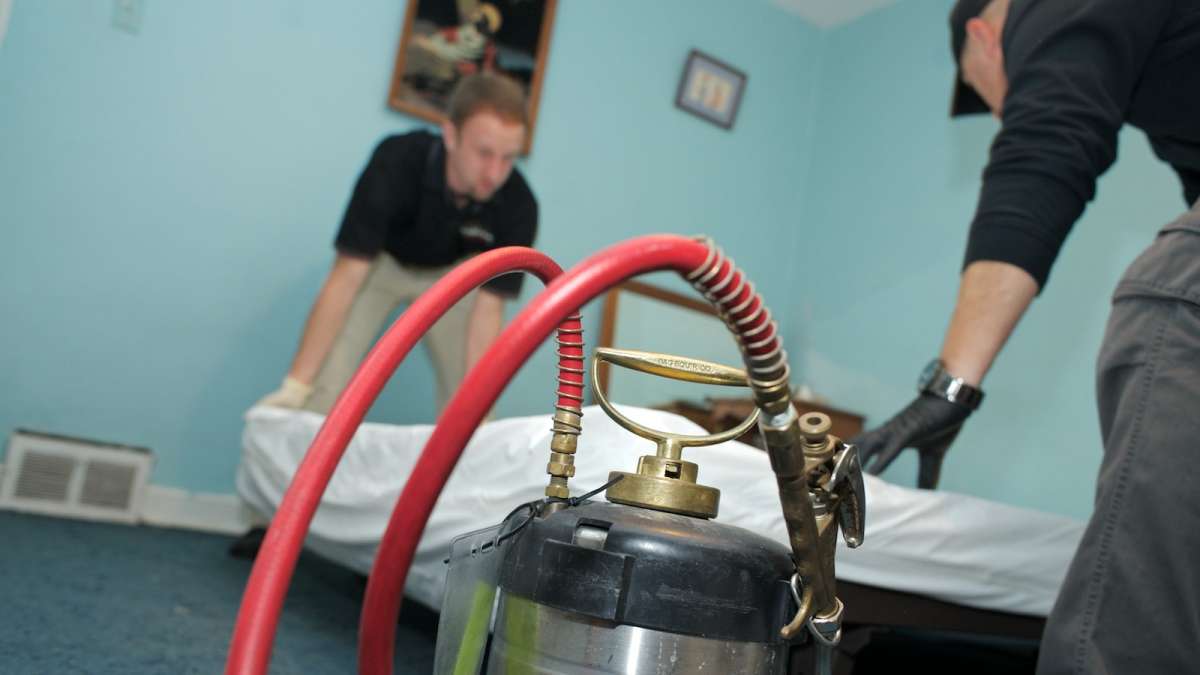Philadelphia’s deep and tumultuous battle with the bedbug
Listen-

-

-

-

-

-

-

-

-

A recently fed male bed bug is found under a mattress during an extermination. (Bas Slabbers, for NewsWorks)
-

-

-

-

-

Are bedbugs making a comeback in places like Philadelphia?
Its scientific name is Cimex lectularius. But it’s commonly known as the bedbug. And it’s made a comeback in places like Philadelphia in recent years, according to area entomologists. While some find bedbugs’ ability to evolve with humans fascinating, these six legged creatures have also spawned stress, anxiety and even economic duress for area households. Some experts battling the bugs have been looking to the past and even south of the border for solutions.
One person’s phobia
Mackenzie McAlpin does not like bedbugs.
“I think I’m wildly scared of them,” she says, sitting in her immaculate South Philly apartment.
As a kid, she’d heard night after night mom recite ‘sleep tight, don’t let the bedbugs bite,’ but didn’t take the reference seriously. That is until learning about problems in New York City a couple years ago.
“They’re real?!” she remembered thinking at the time.
A friend in Philadelphia later confided she’d been battling them. Ever since, McAlpin has admitted to taking some extra, though not always practical, precautions.
“I’m the one friend that crosses the street when we’re walking past a bed,” she says. “I don’t want to know what’s on it. Get me away.”
One can’t blame McAlpin for wanting to avoid them. Bedbugs typically (though not necessarily) feed off human blood at night, resulting in itchy red bite marks for those who are allergic. They hide in cracks and crevices, and their movements can be subtle.
But what if that paranoia turned into something else?
Another person’s obsession
Michael Levy, an area epidemiologist, studies bedbugs and how they work inside and outside his lab at the University of Pennsylvania. Though he wasn’t always seeking them out.
His bedbug fascination can be traced to time spent over the last decade in Latin America, where he met an insect called the Kissing Bug, kind of a “giant horrible cousin of the bedbug.”
Like bedbugs, kissing bugs feed on blood at night. Unlike bedbugs, some can transmit a parasite to humans, which can damage the heart, among other things.
“Every night I’d have my flashlight out and I’d check my room to make sure there were none of these bugs,” says Levy. But slowly, that fear turned into interest. “And then really kind of fascination. And eventually obsession.”
Levy has been working to wipe out the disease in parts of Peru through an ongoing door-to-door extermination and community reporting effort. Though bedbugs pose less of a health threat in the U.S., Levy says they still warrant concern.
“Nursing homes are suffering, institutions are suffering, universities are suffering and everyone quietly deals with it but this is all very discrete,” says Levy. “No one’s kind of taking a global picture of how are we going to control the insects across the city as a whole.”
Inspired by Peru’s model, he’s now leading door-to-door specimen hunts and household surveys around Philadelphia. What he’s finding through that work and in reviewing city complaints is a lot of people have them, but not a lot of people are talking about it.
For one, there’s the false notion that only people who are poor and dirty get bedbugs. Those who are better off, however, may have more resources to fight an infestation. Exterminators alone can cost more than a thousand dollars. The city doesn’t treat bedbugs as a public health threat, so the onus is on individuals to react.
On the household battlefield
Robert DiJoseph and Jeff White, part of a New Jersey-based $1 million battle-the-bed bug business, recently headed a call from a suburban Philadelphia row home.
“We’re bringing lots of little goodies in,” says DiJoseph.
Their lines of attack include:
Protected mattress encasements, which they say trap bedbugs in the bed while keeping others from getting in
Entrapment devices, which look like dog bowls, but when placed underneath furniture and bed legs can trap bedbugs in its smooth surfaced trench as bugs try to crawl up
Flashlights for better spotting bugs
A steamer, as high temperatures can kill bedbugs on the spot
Insecticide (ie: synthetic pyrethroids)
The resident – who describes the devastating mental toll of living with the threat of itchy bites, the feeling of helplessness in protecting one’s kids, and the initial state of denial about the problem – had applied for extermination help through White’s charitable program.
Combatting bedbugs can be expensive, costing upwards of $1,000. One exterminator visit may not guarantee the problem’s solved. Depending on the severity of an infestation, people may need to scrap furniture. But contrary to popular belief, White and other exterminators say with treatment, people usually don’t have to toss out any possessions.
Inside, White and DiJoseph hone in on beds and high traffic furniture, stripping and turning over the box springs, flipping picture frames, steaming a couch, spraying baseboards and inspecting nightstands.
“It’s common to find the bedbugs in the bedding, especially tucked into the foot of the bed because they’re never bothered there,” says White. “Bedbugs want to be in areas of least disruption first. They don’t want to be moved.”
For that reason, White and DiJoseph say they’re not worried about taking the bugs home with them. They also know not to sit down anywhere while on the job. Bedbugs may not be quick to leave a spot, but they may hitch rides on people’s stuff (though they don’t like to travel directly on people). DiJoseph, who deals with bedbugs on a more regular basis, takes an extra step, changing his clothes after leaving places, sealing them in a plastic bag, then throwing them in the dryer on high.
He and others say responding early makes all the difference, before the bugs really infest a place or become endemic in a building or community.
Not a new problem: bedbugs survived the Depression
Bedbugs may be making a comeback, but they are far from a modern phenomenon. Dawn Biehler, assistant professor of environmental studies at the University of Maryland, says bedbugs were a consistent problem in the U.S. up to the 40s and 50s.
“It was almost kind of an accepted condition of urban life that every once in a while, you were going to get bedbugs,” says Biehler. “Some people had bedbugs pretty much constantly.”
True, according to several longtime Philadelphia residents.
“It was awful,” says Eileen Ashton, 81 years old, who recalls waking up with her military family in a Philadelphia hotel to walls crawling with bedbugs.
Families came up with all sorts of responses.
“When I was a little girl, my mother used to open the windows, take the sheets and mattress off the bed, and she used to have a bat and bang the springs with the bat, so all the bed bugs would fall out of the springs,” recalls Phyllis Navo, now 90 years old, of growing up in South Philadelphia.
“We had a lot of bedbugs in them days. Our parents would use some kind of spray on our beds and it stunk,” says John Rodrico, thinking back to the 30s and 40s. “We lived with it, though.”
So what curbed the bedbug?
Biehler says as people “slaved away” at beds and other hotspots in their homes, as hygiene improved, bedbugs became a rarer thing. She points to some success stories during the FDR era, when housing units organized fumigation efforts, where no one person was singled out. Then after World War II, DDT hit the scene “and a whole family of effective, strong chemicals that were good for pest control at the time.”
An evolving problem with some simple responses
Bedbugs didn’t totally disappear, and in a now familiar tale of modern science, they’ve evolved and developed resistance to whole classes of pesticides. Experts also point to crowded cities and increased travel as factors aiding in their survival. It all makes individual responses and the jobs of exterminators White and DiJoseph even trickier.
“That’s one of the really big problems,” says White, who points to mattress encasements and other none chemical devices as important tools.
Reducing clutter, being careful about what goes in and out of the home, hot water laundering and vacuuming are other nonchemical ways to prevent and combat the spread, according to Biehler.
All the more important, says Biehler, because while bedbugs are not known to transmit diseases to humans, they can still cause a “degradation of mental health” with loss of sleep, resulting in family divisions, the feeling that bedbugs are around when they’re not. People can also do themselves more harm in trying to prevent or battle the bugs, applying highly toxic or flammable chemicals excessively.
Meanwhile, Michael Levy, the epidemiologist at Penn, and others, want to get a better handle on the problem as a whole and figure out all the bedbug tricks for moving from place to place. He’ll be starting up another round of door-to-door surveys around Philadelphia, during what’s typically the peak months for bedbugs. So come summer, don’t be alarmed if one day you see a soft-mannered guy knocking at your door, inquiring about bedbugs in your home.
WHYY is your source for fact-based, in-depth journalism and information. As a nonprofit organization, we rely on financial support from readers like you. Please give today.



